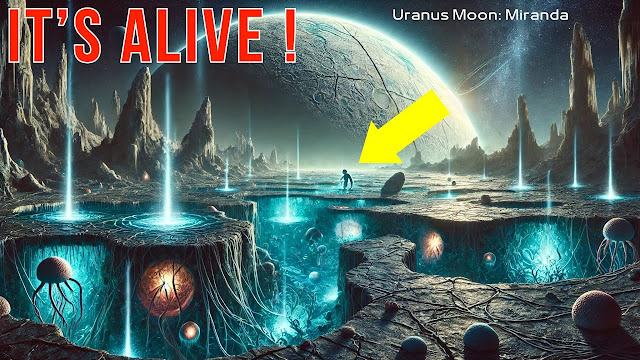Usually, the search for life beyond Earth focuses on the planets or moons with hidden oceans, and the latest one of these is Miranda, the moon orbiting that distant planet Uranus. With new research indicating that this moon actually harbors an internal ocean, Miranda suddenly becomes a contender in looking for extraterrestrial life. Its strange surface and the evidence of geological activity made Miranda one of the most fascinating objects in our solar system.
Miranda: An Odd Moon
Miranda is one of five large satellites orbiting the planet Uranus. Gerard Kuiper was the first to identify it in 1948, and it is the smallest of the major ones, approximately 470 kilometers (292 miles) in diameter. It is an odd moon, since most of the icy moons of our solar system have a strange surface. Miranda is characterized with massive canyons, ridges, and mismatched terrains. These unusual features point to the fact that Miranda has suffered under intense geological activity, probably driven by an internal ocean that would circulate underneath its ice crust. For many years, scientists have speculated the presence of an ocean on Miranda, and recent evidence will begin to prove this possibility.
Evidence of an Internal Ocean
The most convincing evidence for Miranda's potential ocean comes from revised models and simulations on the structure and thermal activities of the moon. Planetary scientists recently reanalyzed data from the Voyager 2 spacecraft, which flew by Uranus and its moons in 1986. The data indicated that Miranda might have a warm, active core, which would be hot enough to maintain liquid water beneath its surface. Such internal heat might arise from tidal heating-a process whereby gravitational forces exerted by Uranus stretch and compress Miranda, generating heat in its core.
A new paper in Journal of Planetary Science introduces the possibility that strange features on Miranda, such as the incredible Verona Rupes-a ten times higher cliff than the Grand Canyon- could be produced by subsurface ocean activity. Intense tidal heating forces could cause openings in the icy surface, and ocean water could fill it up to form the rugged, chaotic landscape we observe today.
Life in an Icy Ocean
If Miranda does indeed have a subsurface ocean, the prospect of life increases with it. As we know it, life relies on three ingredients: liquid water, a source of energy, and a combination of chemicals to fuel biochemical reactions. With this, possibly having an ocean, being supplied with energy through tidal heating, and harbouring the compounds of its rocky core, Miranda could easily qualify.
Miranda's internal ocean may host hydrothermal vents-natural chimneys, like on Earth's ocean floor-where life could exist in conditions otherwise inhospitable," says Proctor, planetary scientist specializing in icy moons. Such vents, if they do exist, might provide the energy and nutrients required to sustain microbial life, even at complete darkness and frozen temperatures.
Investigations of Miranda Prospects
The possibility of an ocean on Miranda sounds very intriguing, but any exploration of it poses severe challenges. Uranus with its moons is very far from Earth, and a dedicated mission there is impossible at this moment. Voyager 2 is still the only spacecraft that has flown by the Uranian system, and after that short visit, scientists got more questions than the answers.
During the past few years, renewed interest has been shown to return to Uranus, and concepts for both NASA and the ESA have been developed, and strong scientific rationale exists for a flagship mission that would more constructively explore the icy moons of Uranus. Such a mission might even come with an orbiter equipped with radar to probe Miranda's icy crust, or a lander designed to analyze the moon's surface.
What's Next for Miranda?
While we're probably many years away from a mission to explore Miranda directly, scientists are still examining existing data and developing new models to inform our understanding of Miranda's interior. Later missions to Uranus should determine whether the ocean indicated by observations is indeed there and could potentially be used to make conclusions about the life that may be on Miranda.
Miranda's unusual attributes and new reservoir of potential as a host for life make it an extremely tantalizing target for further studies. Indeed, if confirmed, the existence of an ocean on Miranda would make it one of the most exciting destinations in the search for extraterrestrial life within our solar system.




.jpg)
0 Comments